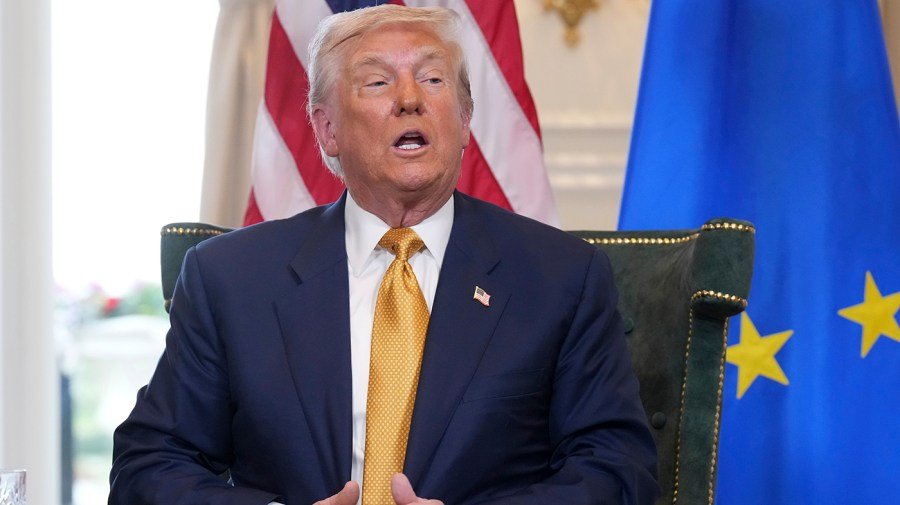
President Trump is staring down a big week on the economy.
White House trade talks are intensifying ahead of Aug. 1 deadline for “reciprocal” tariffs and a Wednesday decision on interest rates from the Federal Reserve.
There will also be second-quarter growth results, the monthly jobs report for July, and price data that could show tariff effects.
Tensions appear to be cooling off between Trump and Fed Chair Jerome Powell after soaring last week during a rare and confrontational joint appearance, but the central bank’s upcoming rate decision could inflame the dynamic again.
Results on employment levels and economic growth could also embolden Trump, who’s been riding high after his tax cuts made it through Congress faster than many had expected. If they fall short, they could put the White House on the defensive or spur a market slump.
Here’s a preview of the economic week ahead for the president.
Trade talks
Talks between the U.S. and China are starting in Stockholm, Sweden, and Trump and U.K. Prime Minister Keir Starmer are fleshing out the U.K. trade deal in Scotland that was announced earlier this year.
Trump’s Aug. 1 deadline for the resumption of tariffs is fast approaching, though China and the U.S. are facing an Aug. 12 deadline following agreements announced in May and June that brought down mutually imposed triple-digit tariffs.
The White House announced a trade deal with the European Union on Sunday that will see the EU purchase U.S. fossil fuels. European leaders are criticizing the deal.
“It’s a dark day when an alliance of free peoples — who are joined to affirm their values and defend their interests — resolve to submit,” French Prime Minister Francois Bayrout said.
Trump has threatened to impose tariffs on any other country that doesn’t make a trade deal before the Aug. 1 deadline, suggesting Monday that that rate would be around 15 to 20 percent.
“We’re going to be setting a tariff for essentially the rest of the world, and that’s what they’re going to pay if they want to do business in the United States. Because you can’t sit down and do 200 deals. But we made the big ones,” he said.
“I would say it would be somewhere in the 15 to 20 percent range,” he added. “Probably one of those two numbers.”
The White House has also insisted they will hold the Aug. 1 deadline, while previous deadlines for tariffs have moved since April.
Meanwhile, Treasury Secretary Scott Bessent is meeting with his Chinese counterparts this week, which marks the third round of talks between the two nations.
“We have a good relationship with China. China’s tough,” Trump said Monday.
Fed decision
The Fed is likely to hold interest rates steady this week at the July meeting of its rate-setting committee, much to the chagrin of Trump, who’s been demanding that the central bank made cuts.
Markets are expecting the Fed to hold overnight interbank lending rates in the range of 4.25 to 4.5 percent. The CME Fed Watch tool put the probability of a pause at 97.4 percent on Monday morning, with the probability of a quarter-point cut at 2.6 percent.
Trump has been telling the Fed to cut rates for months, and the Fed has been holding off due to the expected price effects of Trump’s tariffs.
The tensions boiled over into a televised confrontation between Trump and Powell last week over costs for an ongoing building renovation project at Fed headquarters in Washington.
But Trump backed off of pressure on Powell to resign before his term is up in 2026.
He was asked on Monday if the visit to the Fed could have inspired an interest rate cut this week, and responded that he wouldn’t say anything bad about the chair, despite past criticism.
“I think he has to,” he said about cutting rates.
“I’m not going to say anything bad. We’re doing so well even without the rate cut. With the rate cut it would be better, effects our housing a little bit,” Trump added.
He noted that Powell’s term is up next year.
“I’ll miss him greatly,” he said, sarcastically, of the Fed chair he has been eager to replace.
While the Fed is unlikely to cut this week, its decision may not be unanimous. Fed Vice Chair of Supervision Michelle Bowman and board member Christopher Waller have both called for cutting rates, but not nearly to the scale Trump has demanded.
Jobs report
Economists are expecting to see an uptick in the unemployment rate for July and a slowing in the pace of job creation.
Employers added 147,000 jobs in June and the unemployment rate ticked down 4.1 percent, with about 7 million people out of work. Estimates for July range from 110,000 jobs to be added all the way down to 40,000 jobs.
The main causes cited by businesses are policy uncertainty from ongoing trade deals reducing investment incentives, cost pressures from tariffs, and less immigration.
“While private-sector industries are expected to contribute 88,000 new jobs, public sector employment is projected to decline by 48,000,” EY-Parthenon chief economist Gregory Daco wrote in a Monday analysis.
Daco sees the unemployment rate edging higher to 4.2 percent and the labor force participation rate holding steady at 62.3 percent amid a tighter labor supply.
Earlier this month, the Fed described hiring as remaining “generally cautious,” citing “ongoing economic and policy uncertainty.”
Price data
Price data will come in on Thursday from the Commerce Department’s personal consumption expenditures (PCE) price index, which is the Fed’s preferred inflation gauge.
Economists are bracing for tariff-fueled price increases, which could get a defensive reaction from the president.
PCE prices are expected to have risen to a 2.5-percent annual increase in June from 2.3 percent in May, according to the Cleveland Fed’s inflation projection. Taking out the wobblier categories of food and energy, the index is expected to have risen to 2.7 percent.
Analysts for Deutsche Bank are putting the core number higher at 2.8 percent, which would be its highest rate since February.
Tariffs showed up in June in the other major official measurement, the consumer price index (CPI). The CPI rose to a 2.7 percent annual increase from 2.4 percent in May, the Labor Department reported earlier this month.
“The latest data showed clearer evidence that tariffs are leading to higher prices for core goods components, including recreational goods, household furnishings, and toys, among other categories,” Brett Ryan and others wrote for Deutsche Bank on Sunday.
Gross domestic product
Second-quarter gross domestic product data will come in Wednesday, and the Atlanta Fed is predicting robust annualized growth at 2.4 percent as of Friday.
Annualized GDP in the first quarter shrunk by a half-percent on a huge pull-forward in imports ahead of tariffs. Imports are a subtraction in the GDP calculation.
Analysts say that Trump’s easing posture on trade is what’s fueling the sunnier outlook for the second quarter.
“With the ensuing relents on trade policy, the consensus for second-quarter GDP has not only recouped the decline but is now at the highest it’s been this year,” the Deutsche Bank analysts wrote.
Projections for the third and fourth quarters are lower since that’s when the tariffs will really start to weigh on the economy, they added, comparing conditions to the post-pandemic recovery period.


